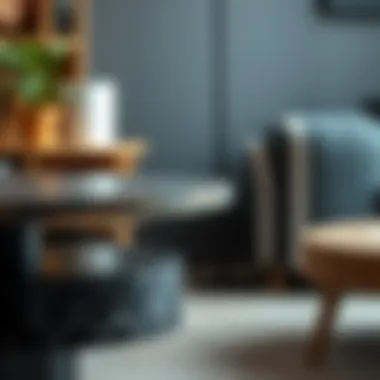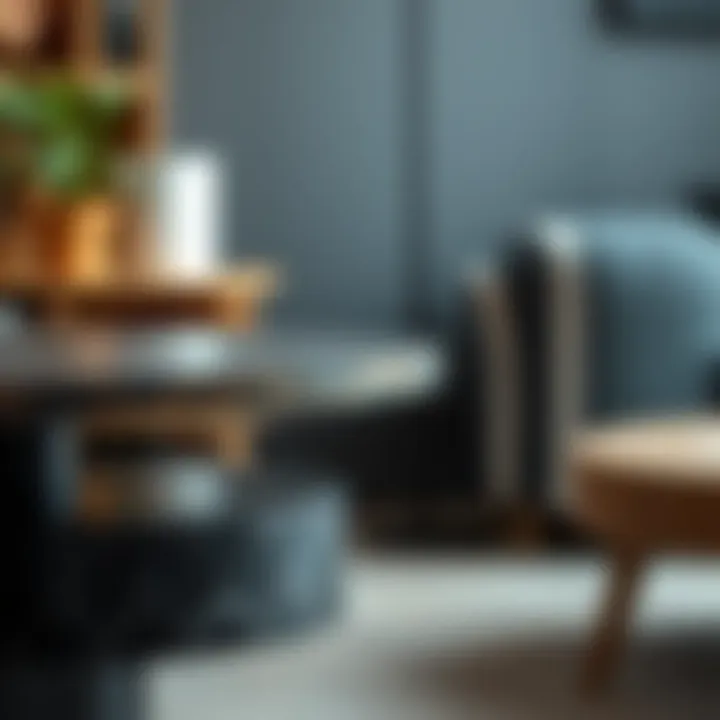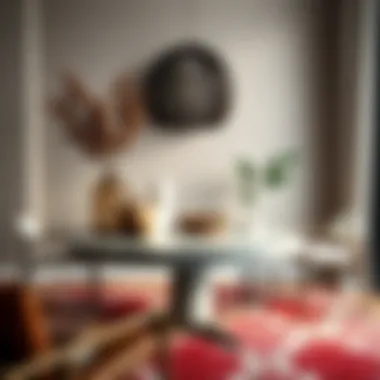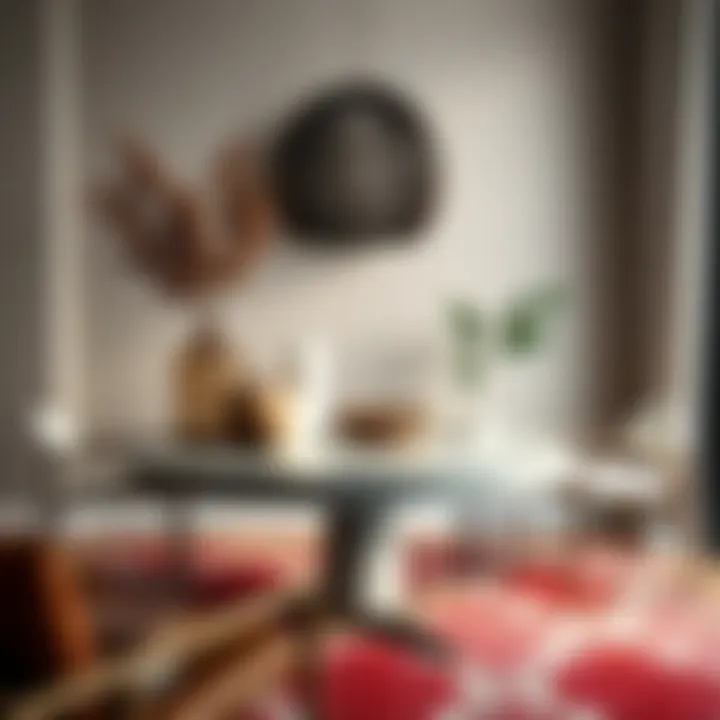Exploring the Design and Use of a 3 Feet High Table


Intro
In the world of interior design, the subtle blend of functionality and aesthetics often dictates the success of a living space. When we examine a seemingly simple piece like a 3 feet high table, we discover its multifaceted nature as it navigates between being a decorative accent and a practical solution. With trends shifting towards more versatile furniture, this table becomes an intriguing focal point for various design styles and scenarios.
Homeowners, designers, and DIY enthusiasts find a treasure trove of possibilities within this piece, as it not only serves as a surface for everyday activities but also as an element that can enhance or disrupt the visual flow of a room. Understanding how to integrate such furniture successfully into differing environments is essential for achieving harmony and functionality.
Furniture Styles and Trends
Without a doubt, the style of table you choose should resonate with the overall theme of your space. A 3 feet high table has the ability to adapt to various styles, from the sleek lines of modern design to the warmth of traditional craftsmanship. Its adaptability ensures that whether you're sipping coffee in a minimalist loft or hosting a family gathering in a cozy cottage, the right table elevates your experience.
Modern vs. Traditional: Understanding the Key Differences
- Materials: Modern tables often showcase metal, glass, and synthetics, leveraging clean lines and minimalism. In contrast, traditional tables are predominantly crafted from wood, emphasizing ornate details and craftsmanship.
- Functionality: While modern designs prioritize flexibility and multipurpose use, traditional ones tend to offer specific functions, focusing on elegance and historical significance.
- Aesthetics: Modern design shuns excess embellishments for an uncluttered look. Traditional styles embrace rich colors, intricate moldings, and textures, fostering a sense of warmth.
By understanding these differences, it becomes easier to choose a furniture style that aligns with your personal taste without forsaking practicality.
Top Furniture Trends to Watch in
- Sustainable design: As awareness of environmental issues continues to grow, there is an uptick in preference for sustainably chic designs, wherein reclaimed materials reign.
- Multi-functional pieces: Flexibility drives trends; people yearn for tables that can serve numerous purposes, whether it be a dinner table, workstation, or even a decorative piece.
- Bold colors and patterns: Injecting energy into spaces with daring hues and eclectic patterns is back. This trend invites creativity, encouraging personalization.
By embracing the current trends while maintaining a focus on practicality, you can select a 3 feet high table that not only serves its purpose but does so with flair.
Practical Tips for Furniture Selection
Selecting furniture for your space can feel overwhelming, but with a few guiding principles, the process becomes more navigable.
How to Choose the Right Furniture for Your Space
- Measure Twice: Always measure your space before selecting any piece. A great table in the wrong size will become a hindrance.
- Consider Traffic Flow: Ensure that the layout allows for easy navigation. A functional piece aids movement rather than obstructs it.
- Think about Purpose: What will you use this table for? Ensure it aligns with its intended function.
Sustainable Furniture: Tips for Eco-Friendly Choices
- Research Materials: Look for certifications like Forest Stewardship Council (FSC) to guarantee sustainability.
- Invest in Quality: Choosing well-crafted pieces often means longevity, reducing the need for replacements.
- Repurpose and Upcycle: Consider giving an old table a second life with a fresh coat of paint or new hardware.
In summary, a 3 feet high table can be a magnificent addition to your home if approached thoughtfully. By navigating the styles and trends and honing in on practicality, you’ll end up with a piece that not only serves its purpose but also enriches your living environment. For further inspiration, you can check resources like Wikipedia, Britannica, and Reddit, where communities engage in discussions around design and functionality.
Understanding the Feet High Table
The 3 feet high table represents a versatile piece of furniture that balances aesthetics and practicality. Its height positions it uniquely in spaces, making it suitable for a variety of uses. Whether it's a café setting where patrons are sipping steaming cups of coffee, or a cozy corner in an apartment where friends gather to share stories, this table can adapt to different lifestyles and needs.
When we consider furniture, especially tables, we often overlook how the right dimensions can enhance functionality. A 3 feet high table serves as a midpoint between the standard dining height of 30 inches and other lower options, like coffee tables. This height allows for easy interaction, comfortable eating, and even workspace without the need for a full dining setup, making it a real gem for compact living.
Historical Context
Tables have evolved significantly over the centuries, influenced by culture, purpose, and materials available. In earlier days, table heights varied greatly depending on societal norms regarding seating and dining practices. The emergence of the 3 feet high table aligns with trends in modern design, which prioritize both form and function.
Back in the day, tables were often crafted from heavy, ornate materials and designed for specific purposes, primarily dining. However, the more practical and accessible versions like the 3 feet high table emerged in response to the need for multifunctional furniture — a reaction to tighter living spaces and the rise of informal dining. It marks a clear shift from rigid formality to a more relaxed aesthetic where comfort and style merge seamlessly.
Common Uses
The beauty of a 3 feet high table is its sheer adaptability to various environments. Here are some common uses:
- Casual Dining: Perfect for simple meals at home, allowing individuals to eat comfortably without the fuss of a full dining set.
- Workstation: In an era where remote work is on the rise, this table can double as an impromptu desk for those working from home, requiring adequate space for laptops and documents.
- Social Gatherings: It acts as a gathering spot for friends, perfect for holding drinks, snacks, and shared conversations, making it an ideal piece for smaller living rooms or outdoor spaces.
- Display Piece: Whether it adorns plants, art pieces, or books, the height makes it ideal for showcasing decorative items without overwhelming the space.
Dimensions and Specifications
The dimensions of a 3 feet high table are somewhat of a sweet spot in furniture design. Generally, a height of 36 inches meets ergonomic standards, providing a comfortable experience for various tasks. Here’s how the dimensions and specifications break down:
- Height: Approximately 36 inches (3 feet) is ideal for standing or seated use at bar stools or high chairs.
- Width and Depth: These tables typically vary but common dimensions include widths ranging from 24 to 30 inches and depths of about 30 to 48 inches, allowing ample surface area without being overwhelmingly large.
- Surface Area: A larger surface area can comfortably facilitate several items, be it food or work materials, while smaller ones can fit snugly into compact spaces.
In essence, the 3 feet high table not only stands as a central piece in any room but also thoughtfully bridges the gap between utility and style. Its strategic height and varied uses make it an integral part of modern furniture design, catering to various lifestyles and preferences.
Design Considerations
When it comes to choosing furnishings, particularly a 3 feet high table, design considerations loom large. This segment embraces the key elements that can make or break the experience of both using and living with such a table. Ultimately, the balance between functionality and aesthetics speaks volumes in how a piece blends into diverse settings.
Proportions and Scale
Understanding dimensions is paramount in furniture design. A 3 feet high table, while seemingly straightforward, carries specific implications in proportion and scale. Placing a table that is too tall in a space with low ceilings can create a cramped and uncomfortable environment, whereas a too-short table may render it unutilized. Achieving the right height ensures that not just the appearance is cohesive, but that the functionality meets expectations.
The visual weight of the table must also be considered. A stout, sturdy table works exceedingly well in more traditional settings, fostering a sense of durability and permanence. Conversely, a sleek, elegant model promotes a more modern, airy vibe.


Moreover, it is wise to consider the surrounding furniture. Creating a balance with nearby chairs, sofas, and other pieces enhances the overall spatial experience. Just like artisans in pottery, harmonizing scale creates a delightful interplay between the elements.
Ergonomics
Ergonomics is more than just a buzzword in furniture design; it is a critical aspect that ensures comfort and utility in daily use. A 3 feet high table needs to accommodate the user comfortably, whether they are dining, working, or engaging with guests. When the table is designed well, it permits natural posture and reduces strain.
Ensure that the tabletop space can accommodate various activities, allowing for both clutter-free dining and productive workspace. Suggesting an ideal clearance from the seat to the undersurface of the table can make all the difference.
In practical terms, choosing an appropriate height can prevent a hunch or a strain. Many tables at this height consider the average height of users when seated. Illustrating ergonomics with a simple anecdote—imagine trying to reach for that last piece of cake at a table that cuts into your knees when leaning in. True comfort needs harmony.
Aesthetic Appeal
When we speak of aesthetic appeal, first impressions do matter. Aesthetics encapsulate how the table contributes to the overall décor of a space. It's less about displaying opulence and more about how the table integrates with its environment. The texture, color finish, and material choices all direct the visual story it tells.
A 3 feet high table can serve as a centerpiece if designed with intention. For instance, a reclaimed wood finish might impart warmth and character, perfect for a rustic kitchen, while a minimalist glass table could enhance a modern office with its sleek outline. Each choice sends a message; thus, understanding your design language is essential.
In terms of style compatibility, one should reflect on whether the aesthetics complement other elements in the vicinity. An eclectic setting might allow for bolder designs with mixed materials, whereas a more traditional layout may benefit from subtle, classic styles.
"In the balance of design, aesthetics and function are like dance partners, each step must align for the experience to resonate."
Ultimately, this section sheds light on the multi-faceted nature of design considerations surrounding a 3 feet high table. Engaging with proportions, ensuring ergonomic comfort, and highlighting aesthetic appeal are essential for a purposeful creation that enhances any space.
Materials and Construction
The material and construction of a 3 feet high table play a pivotal role in determining not just functionality, but also the aesthetic value it brings to a space. Each type of material comes with its own set of advantages, challenges, and considerations that can influence both the longevity of the piece and its fit within a given environment. Homeowners, designers, and DIY enthusiasts alike must navigate these factors to ensure that their choice not only meets practical needs but aligns harmoniously with their intended design vision.
Wood Choices
When discussing wood choices, it’s important to consider both the species and the finish of the wood that will be utilized. Popular selections like oak, walnut, or cherry each offer distinct characteristics. Oak, for instance, is known for its durability and resilience, making it an excellent choice for a table intended for regular use. Walnut, with its deep color variations and rich grain, offers a luxurious feel, while cherry wood brings warmth that can soften even the most modern of designs.
Beyond aesthetics, factors like wood grain patterns, potential for warping, and susceptibility to scratches must also factor in. Finishing options can enhance the texture and look of the wood while protecting it from wear and tear. A hand-rubbed oil finish can accentuate natural grains, while a polyurethane coat offers a more robust protection against the usual bumps and spills of daily life.
"The right wood can transform a simple table into a statement piece, telling a story of craftsmanship that enriches any space."
Metal and Glass Variations
Metal and glass bring a different dynamic to the construction of a 3 feet high table. Metal, known for its strength, can create streamlined designs that stand out, particularly in industrial or modern settings. Materials such as stainless steel or wrought iron offer durability while allowing for intricate designs that can elevate the look of your table. For instance, a stainless-steel base paired with a glass top can create a visually striking contrast, allowing the tabletop to appear almost weightless while maintaining a stable structure.
Glass, especially tempered glass, injects an airy quality into a piece that can make a room feel larger and more open. While elegant, glass requires careful consideration regarding thickness and edge treatment to avoid shattering. Choosing the appropriate glass can also complement the other materials in your design while ensuring safety and usability.
Sustainable Materials
As environmental responsibility gains importance, the selection of sustainable materials has become increasingly relevant. Bamboo is one such option that’s gaining traction—not only is it incredibly durable, but it also grows rapidly and can be harvested without damaging the ecosystem. Reclaimed wood is another sustainable choice, often rich in character and history. Each piece tells its own story, bringing with it a unique blend of colors and textures that can’t be replicated.
The use of recycled metals in construction can also contribute significantly to reducing the carbon footprint of furniture production. Opting for these materials does not limit design choices; rather, it encourages creativity and innovation in construction methods. By choosing sustainable options, you’re not only investing in a piece of furniture but also making a statement about your values.
Incorporating the Feet High Table in Various Spaces
The essence of a 3 feet high table extends beyond mere functionality; it's about adaptability. This piece can fit seamlessly into an array of environments, making it a versatile addition to any home or workspace. Understanding how to effectively incorporate such tables into different spaces is crucial for maximizing their potential. Each area has unique characteristics that can enhance the table's use, offering styles and shortcuts that resonate with both form and function. This discussion seeks to illuminate these elements, providing readers with valuable insights into how to entwine a 3 feet high table into their daily lives.
Living Rooms
Living rooms serve as the heart of the home, a space meant for relaxation and socializing. A 3 feet high table can act as a central focal point, drawing guests in and facilitating conversation. Placing this table in front of a sofa can transform it into a stylish coffee table or a practical spot for drinks and snacks.
Moreover, using a table here allows for various designs, from rustic wood finishes to sleek metal frames, creating a beautiful contrast against plush sofas and vibrant decor. Incorporating unique elements such as decorative trays or plants on top can further enhance aesthetic appeal.
Key Considerations for Living Rooms:
- Size and Scale: Ensure the table doesn't overwhelm other furniture. Proportionality matters in achieving harmony.
- Surface Material: Depending on lifestyle, a durable surface could mean the difference between ease of cleaning and frequent headaches.
- Style Integration: Mix and match with existing decor but keep a cohesive look, to avoid a disjointed appearance.
"A well-placed table can breathe life into a living room, guiding the flow and adding layers of interest."
Dining Areas
In dining areas, a 3 feet high table can redefine how we approach mealtimes. Picture this: a round table that seats four comfortably, perhaps paired with stylish chairs, creating a casual yet intimate dining experience. This table height is ideal for a relaxed dinner, where guests feel less confined than at traditional dining tables.
Additionally, the table's versatility allows it to double as a serving station during gatherings. Envision a buffet-style setup where guests can help themselves, fostering a more communal atmosphere. Choosing a table with storage capacity beneath can also accommodate tableware and linens, adding practicality to the design.
Benefits in Dining Areas:
- Informal Setting: Encourages a laid-back dining experience, perfect for both family meals and entertaining.
- Easy Accessibility: Ideal for all ages, it allows young children to join the fun without needing extra help.
- Flexible Use: Can be repurposed for game nights or casual gatherings.


Office Settings
While we may not traditionally think of a table as a significant player in an office, a 3 feet high table opens up a world of possibilities. Workspaces can appear more inviting and less sterile with this height, removing the barrier typically associated with standard desk setups.
Picture a modern office where collaboration and creativity flourish. A 3 feet high table can act as a shared workspace, encouraging spontaneous meetings and brainstorming sessions. The right table can also feature essential electrical ports underneath, further enhancing functionality for tech-savvy environments.
Important Considerations for Office Settings:
- Space Planning: Ensure the table allows for easy movement within the office to avoid a cramped feel.
- Design Elements: A sleek, minimalistic design can improve the aesthetic, aligning with the professional image of many businesses.
- Ergonomic Factors: Assess if additional seating options will accommodate varied heights to promote inclusivity among users.
Stylistic Compatibility
Stylistic compatibility refers to how well a piece of furniture aligns with the overall design theme of a space. The three feet high table, with its varying designs and materials, can serve as a functional yet stylish centerpiece or complement. Considering its versatility, understanding how this table interacts with different interior styles is essential for achieving a harmonious look.
Traditional Interiors
In traditional interiors, the charm often lies in rich textures, classic color pallets, and timeless designs. When choosing a three feet high table for a space styled traditionally, opt for pieces made from hardwoods like walnut or cherry. These woods enhance the warmth of traditional settings.
- Elements to Consider:
- Design Features: Look for tables with turned legs, ornate carvings, or even inlays.
- Color Palette: Warm, muted tones complement the deep shades typical in traditional designs.
- Accent Pieces: Employ tablecloths or decorative centerpieces to enrich the table’s appearance.
This type of table can function adequately as a coffee table or as a part of a reading nook with a few well-placed books and a soft light nearby.
Modern Design
Modern design is often marked by clean lines, minimalism, and a focus on functionality. A three feet high table fits well into this style, as long as the design reflects the ethos of simplicity and practicality. Materials such as metal, glass, or polished wood can elevate a modern design.
- Key Considerations:
- Simplicity is Key: The table should be unembellished, with a focus on sleek silhouettes.
- Material Choice: Glass tops paired with metal bases can create a light, airy feel.
- Color and Texture: Neutral colors like white, black, or gray will resonate in modern spaces.
In a modern living room, this table could serve dual purposes—holding drinks or snacks while also providing a surface for books or decorative items.
Eclectic Spaces
Eclectic spaces are a marriage of various styles, where creativity reigns and limitations are few. Here, a three feet high table can be a conversation starter, a blend of different materials, patterns, and colors that speaks to personal taste.
- Mix and Match:
- Pair a sleek, modern table with vintage chairs to create an interesting juxtaposition.
- Use vibrant colors or patterns that contrast with other furnishings.
- Accent it with unique items that reflect your personal style, from bohemian to rustic.
In these spaces, the table can serve as a display for artful trinkets, books, and even seasonal décor, lending itself well to the ever-changing nature of eclectic interiors.
Integration Tip: Understand your space’s flow. Ensure the three feet high table invites interactions and complements the room's overall function.
Functional Versatility
The concept of functional versatility plays a crucial role in defining the 3 feet high table's charm and utility. A well-designed piece of furniture should not only serve its primary purpose but also be adaptable to various needs and settings. This adaptability is especially important in today’s fast-paced environments where multipurpose furniture can make all the difference in maximizing space while providing an array of functions.
Multi-purpose Tables
In the realm of furniture, multi-purpose tables stand out as champions of flexibility. Whether it's a family gathering, a board meeting, or a cozy game night, a 3 feet high table fits seamlessly into numerous scenarios. It can act as a dining surface on weekends and transform into a workspace during the week. This kind of flexibility saves homeowners the hassle of having multiple tables cluttering their spaces.
For example, imagine a sleek table that begins its life as an informal dining area for meals but can later be adorned with a few candles and flowers for hosting small gatherings. This dual-role can be complemented with the right decor, easily shifting from utilitarian to aesthetic depending on the occasion without breaking a sweat.
Moreover, many designs now incorporate extendable features, meaning that a compact model can offer more surface area when needed. These tables often come with removable parts or can be adjusted to various heights, allowing singular pieces to fulfill different purposes, thus enhancing small space living.
Storage Solutions
The practical aspect of the 3 feet high table extends beyond its surface area; it also offers innovative storage solutions. In residences where space comes at a premium, integrating storage into furniture design is a game changer. Many modern tables come equipped with drawers or shelves that provide discreet yet accessible storage for essential items like coasters, magazines, or even board games.
"In sanely designed tables feature integrated shelving which minimizes clutter while adding an aesthetic touch."
Additionally, storage-focused designs can help keep different living areas organized. For instance, the living room can remain clutter-free when a table serves as the storage hub for remote controls and chargers. Alternatively, in an office setting, it can house supplies and paperwork within easy reach.
Furthermore, there are increasing options in the market that emphasize eco-friendly materials for this storage aspect. Recycled wood or sustainably sourced materials not only make for sturdy designs but also resonate with users who prioritize sustainability in their purchasing decisions. This conscious choice can reverbate positively across a home, bridging practical design with mindful living.
In summary, the exceptional functional versatility of a 3 feet high table offers homeowners, designers, and DIY enthusiasts an incredible value proposition. With its potential as a multi-purpose item and a clever storage option, it transcends the conventional notion of furniture, morphing into a true asset within any living environment.
Maintaining and Caring for a Feet High Table


When considering the longevity and appearance of a 3 feet high table, it is crucial to focus on its maintenance and care. This piece of furniture is not only functional but also a centerpiece in many homes. How we care for it can significantly influence its lifespan, aesthetic appeal, and overall practicality in daily use. Given the variety of materials and finishes utilized in these tables, tailored care methods are essential.
Cleaning and preserving these tables ensures they not only serve their intended function but also remain attractive focal points in your living spaces. A table that sparkles with cleanliness and looks as good as new is appealing not just to the eye but also enhances the general ambiance of the room.
Cleaning Techniques
Let's dive into some practical cleaning techniques suitable for different materials. Design and functionality don’t mean much if a table is grimy or damaged.
- Wood: For wooden tables, a soft, damp cloth is usually your best bet. Wipe down the surfaces to pick up dust and debris without scratching the finish. Avoid using too much water, which can warp the wood. If you've got sticky residue, a mix of vinegar and water can often do the trick, just remember to follow up with a dry cloth.
- Metal: For those stainless steel or metal accents, a gentle metal cleaner works wonders. Just spray a bit onto a soft cloth (never directly on the table) and wipe in the direction of the grain. Regular maintenance can prevent fingerprints from becoming a persistent eyesore.
- Glass: If your table features a glass surface, then a streak-free glass cleaner is your friend. Spray it on and use a microfiber cloth to achieve a smudge-free shine. This keeps your tabletop looking sleek and inviting.
In cleaning, the goal is not just cleanliness but also to enhance the table's usability and ensure it doesn’t wear down prematurely. As they say, "A clean home is a happy home," and that rings true for your furniture too.
Preservation Tips for Various Materials
Each material demands specific care to keep its charm intact. Knowing how to preserve your table can make all the difference.
- Wood: Over time, wood can dry out and lose its sheen. To keep it nourished, periodically apply a high-quality furniture polish or mineral oil. This gives the wood a lovely glow while also preventing it from cracking.
- Metal: Protecting metal surfaces from rust or corrosion often requires a simple routine of checking for scratches or chips. Applying a clear coat finish can also help, especially in areas with high humidity.
- Glass: For glass tops, avoid placing heavy objects directly on the surface unless necessary, as this can lead to chipping or scratching. Additionally, coasters are a must to prevent stains from drinks. Always lift rather than slide items to maintain integrity.
Trends in Design
When it comes to furniture, staying in tune with trends in design is essential. The pieces we choose are not mere utilitarian objects; they can impact our daily lives, personal expression, and the overall vibe of our spaces. A 3 feet high table is no exception, embodying both a practical function and aesthetic qualities that evolve with time. This section simply emphasizes how important it is to keep an eye on emerging styles and preferences in table design.
Current Market Trends
Today, the market is rife with various themes and styles, reflecting broader cultural shifts and individual tastes. Among the noteworthy trends for a 3 feet high table are:
- Minimalism: A penchant for simplicity is driving the popularity of clean lines and uncluttered forms. Homeowners are gravitating toward tables that eliminate unnecessary embellishments without compromising elegance.
- Sustainability: Eco-conscious materials like reclaimed wood or bamboo are gaining ground. Buyers are showing preference for pieces that reflect their values, opting for those crafted from sustainable resources.
- Multi-functionality: The modern homeowner prefers furniture that serves several purposes. A 3 feet high table can easily act as a workspace, dining area, or even serve storage functions—hence capturing the essence of versatility.
- Industrial Aesthetic: Raw materials like metal and concrete juxtaposed with warmth from wood create a striking balance. The industrial charm continues to resonate by imbuing spaces with an edgy yet homely feel.
These trends reflect a broader shift towards creating spaces that are not only visually appealing but also serve a range of practical functions.
"Design is not just what it looks like and feels like. Design is how it works."
– Steve Jobs
The Future of Table Design
Looking ahead, several elements signal what the future might hold for 3 feet high tables. Here are a few aspects to consider:
- Smart Technology Integration: As homes become smarter, so too will tables. Imagine a 3 feet high table equipped with wireless charging capabilities or smart surfaces integrated with touch-sensitive controls for various settings and preferences.
- Customization Options: The demand for unique, personalized furniture continues to rise. We can expect advancements in modular designs, allowing each homeowner to customize their table based on size, color, and material preferences.
- Alternative Materials: The pursuit of innovation will likely introduce unconventional materials into table design—think bioplastics or even living materials. Such shifts could change how we perceive not just functionality but aesthetic appeal as well.
- Focus on Comfort: Ergonomic considerations will play a key role in future designs. With more awareness of health and wellness, tables will be crafted keeping comfort in mind, adjusting heights and forms to suit diverse needs.
Keeping abreast of these trends could empower homeowners, designers, and even students to make informed decisions that blend utility with style effectively.
As trends in design evolve, it’s crucial to reflect on how they impact the choices we make, ensuring our selections are not just temporary fancies but lasting integrations in our homes.
Challenges and Considerations
Exploring the challenges and considerations surrounding a 3 feet high table allows us to understand the practical implications and the overall design philosophy behind its use in different spaces. In this section, we highlight how these factors impact both functionality and aesthetics. It’s more than just a piece of furniture; it’s part of a larger narrative in our daily lives.
Space Limitations
When deciding on the placement of a 3 feet high table, space limitations are a vital factor to consider. Not all homes, offices, or gathering areas have the luxury of expansive square footage. In tight quarters, every inch counts. The height of a table can significantly influence its perceived space, blending or clashing with nearby furnishings.
- Small Spaces: In compact living environments, like studio apartments, a 3 feet high table can serve as a multi-functional hub. However, if it’s too bulky, it may overcrowd the area, making the space feel cramped.
- Layout Design: The arrangement of other furniture influences how a three-feet table interacts with its surroundings. For instance, placing it too close to a sofa or chair might limit movement, leading to a less than optimal flow in the space.
It's a balancing act, ensuring that the table serves its purpose without hogging the limelight. Homeowners should measure both the dimensional space available and the scope of functionality required from the table. Often, a compact design can fit right in, yet provide a massive boost in utility.
User Preferences and Needs
Understanding user preferences and needs adds another layer to the functionality of a 3 feet high table. Every person is different, and their requirements can dictate the usability of such a piece:
- Lifestyle Choices: For homeowners who frequently host gatherings, a table that can easily adapt to serve snacks or drinks is invaluable. On the other hand, for those living alone, aesthetics might take precedence over utility.
- Personal Style: Individual taste plays a massive role. A mid-century modern design may not appeal to those who prefer minimalist artistry. Taking user preferences into account ensures that the table doesn’t just serve a purpose but resonates with the users' personal style.
- Ergonomics: While the height is fixed, the actual usability goes beyond that. The table should be comfortable for its intended activities, whether it’s working from home, enjoying meals, or facilitating social interactions. With work-from-home becoming the norm, a height that suits sitting or standing tasks becomes crucial for engaging productivity.
Ultimately, preferences shape practical use; tables need to cater to individuals and how they wish to engage with them.
Ending
The conclusion serves as the anchor point in the exploration of the 3 feet high table's dimensions, emphasizing its multifaceted role in contemporary design. A well-crafted conclusion not only encapsulates the key insights but also underscores the significance of integrating such furniture into various living environments. This piece has dissected the table's historical context, material choices, and stylistic compatibility, making it clear that this furniture piece is not merely functional but an essential element of aesthetic expression.
Summation of Insights
In summary, the 3 feet high table stands as a testament to the marriage of form and function. Its design can suit a range of purposes, from providing a casual dining experience to serving as a statement piece in a living room. The consideration of proportion and scale has emerged as crucial; a table that disrupts the visual harmony of a space can detract from the overall ambiance. As explored earlier, the choice of materials—be it the warm tones of reclaimed wood or the sleek finish of tempered glass—also plays a vital role in how the table interacts with surrounding elements.
"Good design is obvious. Great design is transparent."
This adage resonates when considering how seamlessly a 3 feet high table can mesh with existing décor. It is not just about its height or style; it’s about enhancing user experience and encouraging social interactions. By synthesizing the insights throughout the article, one can appreciate that the right table doesn’t just occupy space but actively enhances it, becoming a gathering point in homes and offices alike.
Final Thoughts on Design Integration
The final consideration for incorporating a 3 feet high table lies in its versatility. Homeowners and designers must take the time to envision how this piece fits within their specific contexts, taking user preferences and space limitations into account. Each table embodies potential, urging a thoughtful approach towards design integration. As we've seen, whether it’s nestled against a wall in a modest apartment or featured prominently within a vast office, its effectiveness is greatly dependent on careful planning and intentionality.
As we look to the future, evolving trends will continue to shape the landscape of furniture design. These insights gleaned from the exploration of the 3 feet high table remind us that thoughtful, intentional design has the power to transform spaces and elevate interactions. Homeowners and designers should embrace this potential, using the lessons learned to innovate and inspire.







